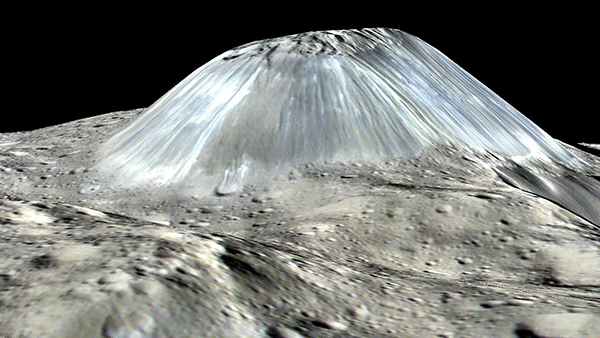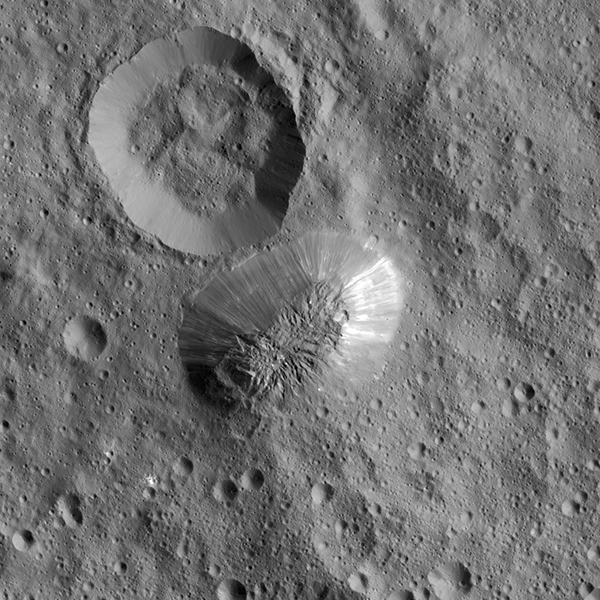
by Dana Drew Thursday, April 27, 2017

A simulated perspective view of Ahuna Mons, a cryovolcano on Ceres, with the elevation exaggerated by a factor of two. Credit: NASA
Earth has numerous volcanoes, both active and extinct — some of which continue to tower over landscapes long after they finished erupting. On the chilly dwarf planet Ceres, however, scientists have identified just a single volcano — an ice-erupting cryovolcano — raising questions about whether others ever existed there and, if so, what happened to them. In a new study, researchers suggest that Ceres has likely had other volcanoes, but that, over time, their icy slopes have been flattened beyond recognition.
Ceres is the largest object in the asteroid belt between Mars and Jupiter, and the only dwarf planet located in the inner solar system. NASA’s Dawn spacecraft has been orbiting Ceres since September 2012, acquiring data and detailed imagery. In 2015, this imagery revealed a 4-kilometer-tall cryovolcano named Ahuna Mons, thought to have formed no more than about 210 million years ago, young in geologic terms. Cryovolcanoes like Ahuna Mons are analogous to volcanoes on Earth in terms of shape and structure, yet instead of erupting molten rock, they erupt mixtures of mud, salt and ice.
Ceres is considered an ideal location to study cryovolcanoes because it is the closest large object to the sun that has abundant ice in its interior, but the solitary existence of Ahuna Mons puzzled scientists. “Why would Ceres be geologically dead for the first 4.5 billion years of its existence and then become geologically active,” producing Ahuna Mons only recently, asks Michael Sori of the Lunar and Planetary Laboratory at the University of Arizona and lead author of the new study, published in Geophysical Research Letters.

Ahuna Mons as seen by NASA's Dawn spacecraft from 385 kilometers above the surface of Ceres in December 2015. Credit: NASA/JPL-Caltech/UCLA/MPS/DLR/IDA/PSI
Sori and his colleagues hypothesized that other, older cryovolcanoes had existed on Ceres, but that they disappeared to the point that they could not be seen readily in the Dawn images. To test the idea, they developed an ice-flow model based on observations of material properties, temperatures and topography on Ceres. The model demonstrated that, with the right ice content and temperature conditions, cryovolcanoes there will gradually vanish over geologic time, broadening and flattening like syrup settling around the base of a stack of pancakes, through a process called viscous relaxation. The same mechanism governs the flow of glaciers on Earth, Sori explained. “The more ice you have, the more something will flow,” he says, and “the warmer it is, the more it will flow.”
Using the ice-flow model, the team predicted that Ahuna Mons and other cryovolcanic domes on Ceres are likely composed of at least 40 percent ice, and therefore should flow at velocities between 10 and 500 meters per million years. Under these conditions, Sori and his colleagues reported that many older cryovolcanoes have likely disappeared from view due to viscous relaxation. They also noted that young Ahuna Mons may not experience noticeable changes for another 10 million years or so.
Steven Desch, an astrophysicist and planetary scientist at Arizona State University who has studied cryovolcanism on Pluto and its moon Charon, says he would expect a large amount of cryovolcanism on Ceres. Consequently, “a reason [like that put forward by the new study] for why cryovolcanism is not observed makes total sense,” Desch said.
According to both Sori and Desch, there is growing evidence for cryovolcanism on a number of icy bodies in the solar system — including Ceres, Pluto and Charon, as well as Saturn’s moon, Titan, and Jupiter’s moon, Europa — thanks to observations from recent space missions like Dawn, New Horizons and Cassini. Sori says the next step for his team will be to continue to use data from the Dawn mission to search for older, less obvious cryovolcanoes on Ceres, which the researchers now expect to be much flatter and broader than Ahuna Mons. If they discover them, they can then use these older features to test their flow model, and to estimate the total amount of cryovolcanism on Ceres through geologic time. Knowing the amount of cryovolcanism on Ceres, and other icy objects in the solar system, will help researchers constrain its role in the development and evolution of the surfaces of these objects. “Cryovolcanism may be as important to outer [solar system] bodies,” Sori says, “as volcanism is to inner bodies.”
© 2008-2021. All rights reserved. Any copying, redistribution or retransmission of any of the contents of this service without the expressed written permission of the American Geosciences Institute is expressly prohibited. Click here for all copyright requests.